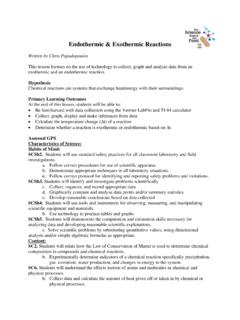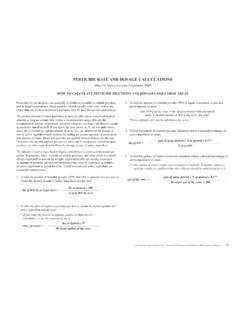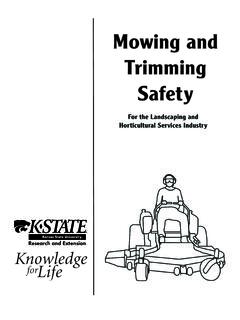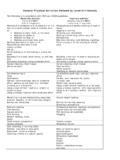Transcription of Force, Speed and Horsepower - University of Georgia
1 force , Speed , and Horsepower From this lesson, students will gain an understanding of energy, force , work, power, Horsepower , and torque. The lesson will use items familiar to students to better explain the concepts listed above. This lesson contains both a hands-on and lecture component. Primary Learning Outcomes What are energy, force , work, power, Horsepower , and torque and what applications do these have in our everyday lives? Assessed Georgia Performance Standards SPS8. Students will determine relationships between force , mass, and motion.
2 A. Calculate velocity and acceleration b. Apply Newton s three laws to everyday situations by explaining the following: Inertia Relationship between force , mass, and acceleration Equal and opposite forces c. Relate falling objects to gravitational force d. Explain the difference in mass and weight. Procedures/Activities Step: 1 Duration: 1 hour 30 minutes Discussion with students concerning energy, force , work, power, Horsepower , and torque. Discussion will also include the concept of the conservation of energy. A brief background of these concepts is included.
3 Step: 2 Duration: 30 minutes Review concepts covered in previous days lecture before entering into the lab portion of the discussion. Step: 3 Duration: 1 hour Laboratory portion of lesson in which students will measure the amount of force needed to move an object. Objects of different sizes will be used for comparison. The difference in force used to lift an object and to push or pull an object can be demonstrated with a scale and some object to lift or pull. Attach scale to object and lift the object. In effect, you are weighing the object.
4 You are also demonstrating the force required to move the object vertically. Next, tie the scale to the object and pull the object with the scale. You are now demonstrating the force required to move the object in a direction other than vertically. Relate this force difference to the simple machine of an inclined plane.) Can be measured in pounds (lbs.) Materials and equipment Scale that will weigh up to at least 50 lbs Object weighing 50 lbs or less 10 feet of rope Meter stick Total Duration 3 hours Assessment Students will be assessed with an exam on the concepts and formulas discussed in the lesson, as well as be graded on a set of questions that accompany the lab exercise.
5 Discussion of Concepts 1. What is energy? A. The resource that provides the capacity to do work. B. Two forms are potential energy and kinetic energy. Potential energy is stored energy a body has due to its position, chemical state or condition. Examples: -Position- water stored behind a dam -Chemical - gasoline -Condition - a spring compressed Kinetic energy is energy in motion. In effect it is released potential energy. Examples: -Water falling over a dam -a riding lawn mower moving -a spring released.
6 C. The law of conservation of energy states that energy cannot be created or used up. The amount of energy is fixed. Energy can be converted from one form to another, but energy is not used up. 2. What is force ? A. anything that changes or tends to change the state of rest or motion of a body(mass). B. Sir Isaac Newton formulated laws, which explain the way objects move. One of his laws states: An object that is moving or at rest does not change its state of motion unless a force acts on it.
7 C. Motion is started or stopped by a force . D. Once in motion objects tend to stay in motion, and it takes a force to change the direction or Speed of an object in motion. E. force is also defined as any push or pull applied to an object. Gravity is a force that pulls down on every object on the earth. The weight of an object is actually how much force of gravity is pulling on the object or how much force is being applied in a vertical position. When a person lifts an object, that person must exert enough force to equal the pull of gravity on the object.
8 F. force is measured in units such as pounds, ounces, grams, etc. For instance, if a person lifts a 60-pound object, the person must exert 60 pounds of force on the object. G. force is also the measurement of a push or pull against an object other than in a vertical direction. If a person pushed or pulled a 60-pound object rather than lifted the object, the amount of force required to move the object may be less (or more) than 60 pounds. For instance, it may take only 40 pounds of force to push the object. If a part of the object is in the ground, it may take more than 60 pounds of force to move the object.
9 When determining the force required to move an object in any direction other than vertically, it is not necessary to know the weight of the object. The force required will be determined by how difficult it is to pull or push the load. 3. What is work? A. The force applied to an object throughout a distance. In other words, when a force is applied to an object and that force causes motion or movement, work has occurred. B. An Example is: moving an object against an opposing force . $ When a lawnmower is pushed, and the force applied is sufficient to start the motion of the lawnmower in opposition to the friction produced by the wheels and thick grass, work is produced.
10 $ After the mower is moving, it will remain in motion until another force stops it. C. Work = force X Distance. The unit of measure for work is foot-pounds (or Inch-pounds, inch-ounces, etc.). $ Example #1: A person lifts a 60-pound object 2 feet vertically. The work that has been done is: Work = 60 pounds x 2 feet = 120 foot pounds of work. $ Example #2: A person exerts 40 pounds of force to pull an object 2 feet. The work that has been done is: Work = 40 pounds x 2 feet = 80 foot pounds of work. Note: If force is applied to an object and the object is not moved, no work is done.












